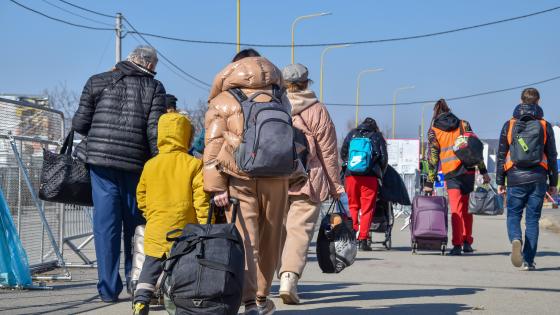This column introduces a CEPR report arguing that policy towards asylum seekers should be based on historical insight, on quantitative evidence, and on a realistic view of the political economy of asylum policy. With this background, the report argues for a more centralised European asylum system and for a range of specific policy reforms.
Seeking asylum has a long history but the present international regime dates back to the enactment of the UN Refugee Convention, almost exactly 60 years ago. It was framed in the aftermath of the mass displacements during the Second World War and against the background of the gathering Cold War. It provides that (a) each application is judged on its merits against the criterion of “a well founded fear of persecution” (b) that no applicant can be sent back to a situation where he or she would face persecution, and (c) illegal entry or presence in a country does not restrict access to the process or affect its outcome.
In the early years, refugees fleeing communism were a powerful symbol of the superiority of the West, and most were permanently resettled. The refugee regime expanded in the 1960s and 1970s as it gained momentum from the human rights movement. Just as the liberal asylum regime reached its apogee in the 1980s, the number of asylum applicants spontaneously arriving at the doors of Western countries began a steep ascent. It was fuelled by proliferating civil wars and better access to the developed world, and it reached a peak following the fall of the Berlin Wall and the collapse of the Soviet Union.
The rise in asylum applications was followed by a policy backlash during the 1990s that reverberates to this day. It involved (a) restricting access by tightening border controls and visa requirements, (b) applying tougher criteria in the refugee-status-determination procedures, and (c) imposing harsher living conditions on applicants. These policies were made even tougher after the 9/11 attacks. At first, policy seemed to have little deterrent effect on applications. But negative effects are revealed when controlling for war and terror in source countries. The most recent estimates suggest that policies on access to the country and on the processing of applications had negative effects but those on living conditions did not.
What underlay the policy backlash? Over time, public opinion towards refugees soured. While most people are supportive of genuine refugees, the term “asylum seeker” became conflated with illegal immigration and benefit seeking. Anti-asylum sentiment has been stoked by the media and by the political debate, which has raised the salience of asylum as a policy issue. This is reflected in mainstream party politics and in the rise of far-right parties. Indeed, the evidence suggests that policy toughening is correlated with votes for far-right parties – even where they do not form part of the government.
So what to do? Some argue that the Convention has outlived its usefulness. But despite its flaws, it provides a robust and flexible instrument, and it commands widespread support. Another line of thought has been to augment the existing refugee regime with policies that strike at the social and economic causes of displacement. Such proposals sound good but have conspicuously failed. Policies to improve conditions in refugee camps and to promote repatriation have met with modest success. Closer to home, the EU has been building a Common European Asylum System that has involved harmonising some elements of policy but is still far short of a fully integrated system.
The case for a fully integrated Europe-wide asylum system rests on two grounds. The first is that genuine refugees can be thought of as a public good; the gains are general but the costs are local. Public goods paid for locally will therefore be underprovided. The social optimum would entail more generous asylum policies, but the degree of toughness will differ between countries according to the volume of applications they face. Complete policy harmonisation needs therefore to be augmented by a more centralised system for distributing asylum claims between countries.
The second argument is pure politics. Partly because of media hype, far-right parties and factions have more influence over asylum policy than average public opinion would warrant. So shifting to the EU level would take some of the heat out of national debates. But would the average voter accept this? In the European Social Survey, 57% of respondents say they would prefer immigration and asylum policy to be set at a supra-national level. This result is similar to that for other “public good” type policies (and much higher than for agriculture or interest rates – where policy is centrally determined).
The EU has taken some steps towards centralising asylum policy. One development is FRONTEX, the unified border control system. Another is the European Refugee Fund which is a central fund that can be used to support countries facing large asylum inflows. Most recently the European Asylum Support Office has been set up in Malta. This office is charged with fostering information exchange and disseminating best practice methods. It is also expected to assist in the relocation of recognised refugees. But providing advice and logistical support does not constitute taking control over asylum policies.
One of the key conclusions of the report is that the EU should adopt an integrated asylum system with uniform policies. So how would that work and what policies should it pursue? Here is a short list of priorities.
- Establish a European Asylum Support Office “cell” in each major country of asylum to implement EU policy through existing national institutional structures.
- Fully harmonise the policies in the existing EU directives. These include a common approach to who qualifies as a refugee and the procedures that are applied in processing applications as well as appeals procedures and reception conditions.
- Set a maximum “quota” of applications for each EU country and then redistribute over-quota asylum seekers. A corollary is that the “Dublin regulation”, which returns asylum seekers to the first EU country that they entered, must be abandoned.
- Strengthen the Temporary Protection Directive in order to allocate a sudden surge of refugees across the EU. This directive can only become effective if it includes a specific trigger to activate it and a formal mechanism for distributing refugees.
- Expand the use of Temporary Protection visas. If refugees are seen to return when conditions improve in the source country, then more places could be provided for those with current and pressing needs for protection.
- Improve living conditions for asylum seekers and strengthen policies to promote access to the labour market. In particular, abandon detention in the vast majority of cases (as it is not an effective deterrent) in favour of other methods of keeping track of asylum seekers.
Reference
Hatton, Timothy J (2011). Seeking Asylum: Trends and Policies in the OECD. London: CEPR.


